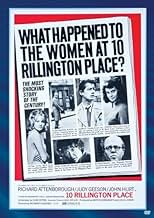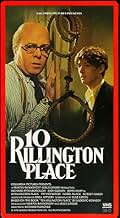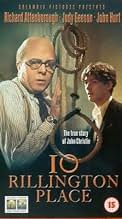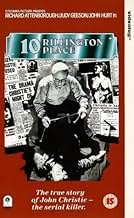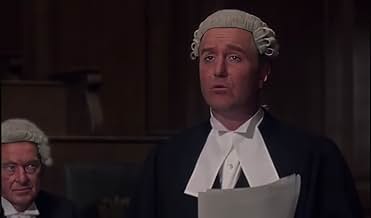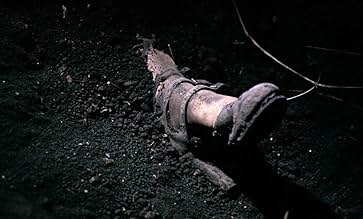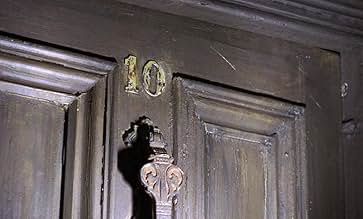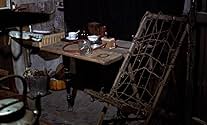Füge eine Handlung in deiner Sprache hinzuWhat happened to the women at 10 Rillington Place? The story of British serial killer John Christie, who committed most or all of his crimes in the titular terraced house, and the miscarriag... Alles lesenWhat happened to the women at 10 Rillington Place? The story of British serial killer John Christie, who committed most or all of his crimes in the titular terraced house, and the miscarriage of justice involving Timothy Evans.What happened to the women at 10 Rillington Place? The story of British serial killer John Christie, who committed most or all of his crimes in the titular terraced house, and the miscarriage of justice involving Timothy Evans.
- Regie
- Drehbuch
- Hauptbesetzung
- Nominiert für 1 BAFTA Award
- 1 Nominierung insgesamt
- Judge Lewis
- (as Andre Morell)
Empfohlene Bewertungen
Richard Attenborough takes the lead role and does fantastically well with it. His calm mannerisms and nonthreatening demeanour clash well with the underlying evil of his character and we really can believe that this man is a maniac. The film was made in the United Kingdom, I'm proud to say, and this is obvious throughout. UK films have a certain atmosphere about them, and although I didn't know that this movie was homegrown before watching it; it soon became apparent. This style bodes well with the theme of the film, as it's downtrodden and makes sure that the film is firmly planted in the land in which the story took place. The idea of an innocent man not only going down, but being killed, for a crime he did not commit is shocking and the cold way that it is presented in this film reflects the fact that it actually happened and also gives it more of a degree of shock. On the whole, 10 Rillington Place is a film that shouldn't be missed by anyone. It's not all that well known, but this is unfair considering the quality of it and I wont hesitate to recommend this movie to people in the future.
The film itself is a dark and brooding masterpiece which depicts life in post-war London perfectly. The grim, dirty, rain-washed Rillington Place in Notting Hill was a seedy side-street which housed the poor but largely respectable families which had survived the blitz. John Christie had moved down from the North to find work in the capital but ill-health and a penchant for petty crime prevented him from being successful.
Richard Attenborough plays the downtrodden but curiously arrogant Christie to perfection. His voice almost a whisper as he lauds it over London's underclasses. In fact Christie was not a landlord, as many believe, he was merely a tenant who fancied himself to be a landlord and acted accordingly. He also dreamed of being a doctor, with devastating consequences. His treatment of the poor, subnormal Evans (John Hurt) and his beautiful but foolish young wife, Beryl, (Judy Geeson) was centred around their desire for an abortion - illegal in the UK until the late 1960s.
John Hurt is very good as the hapless Evans although his Welsh accent needed refining. His look of wide eyed horror and disbelief is a sight to behold. Geeson pouts and whinges and looks gorgeous: the kind of wife any man would desire and yet the kind destined to irritate intensely.
The key to appreciating 10 Rillington Place is to have some idea of its setting in British history. To wander in clueless will result in disappointment. There is no gore or x-rated content of any kind and its slow pace will infuriate many. Yet, as a snapshot of an England now gone and a reminder of the folly of capital punishment it is a timeless classic worthy of many viewings.
The movie's not only a reflection on the death penalty, but on anti-abortion laws, as well. Those desperate women wouldn't have been driven into the clutches of the lunatic Cristie were abortion licensed and legal. That may not have stopped his madness, but he would have had to come up with a different ploy.
The movie focuses on one particular episode (the Evans killings) rather than the series of killings that actually covered a considerable time period. So, cooped up in the city, Cristie ends up hiding his many victims where he can (in the garden, in the washroom, in the walls). What surprises me is that no one, least of all, the wife, notices what must have been an atrocious smell.
Note the dispatch with which Evans is hanged, unlike the more ritualized American way. I assume the movie is an accurate depiction. He walks into an ordinary room, the hood is placed over his head, and plop, the trapdoor opens. And it takes just about that long. The suddenness really startled me.
Contrast two ends of the serial killer spectrum—the shy, unattractive Cristie and the charming, handsome Ted Bundy of 1970's America. Understandably, Bundy had no trouble luring girls to their doom; judging from the movie, however, Cristie's victims must have been truly desperate to let that little creep lay hands on them.
Not mentioned in the movie, but in one of the books that I recall, is that Cristie kept swatches of pubic hair as trophies.
Like any good document on serial killers, the film presents a glimpse of lives and social levels that otherwise go unnoticed. Here we get a sense of a decaying part of London and the dreary lives hanging on there. A good movie or book is like a knife slicing through a cake, exposing layers that otherwise remain hidden. That's the particular strength of this film.
My only reservation is the casting of Judy Geeson as Evans' wife. She seems too pretty and smart to be hooked up with a dead-ender like Evans. Still and all, Geeson's performance is excellent— note her subtle expressions on first meeting the creepy Cristie. Nonetheless, I suspect her casting was the one concession the producers made to commercial appeal.
All in all, it's a grim, ugly film-- as it should be. We may not get much sense of why Cristie has taken the warped, monstrous turn he has. But then such dark matters may be beyond us, anyway. Above all, the movie should not be viewed in a depressed state or if you're looking for a room to rent.
Wusstest du schon
- WissenswertesRichard Attenborough's make-up, mainly consisting of a bald pate, took three hours to apply every morning.
- PatzerWhen Christie is explaining the procedure he's about to perform on Beryl, he says that natural gas contains carbon monoxide, then quotes its formula as CO2 (which is actually carbon dioxide). The correct formula for carbon monoxide is CO. However, the point appears to be to show him for the half-educated conman he is. It's just Christie's character creating an air of "expertise".
- Zitate
John Reginald Christie: It's the moral question that concerns me, the taking of life - no matter how rudimentary.
Beryl Evans: It's not really... I'd be ever so grateful, Mr Christie.
- Crazy CreditsPrologue to opening credits: "This is a true story. Whenever possible, the dialogue has been based on official documents"
- VerbindungenFeatured in Interview with Sir Richard Attenborough (2004)
Top-Auswahl
- How long is 10 Rillington Place?Powered by Alexa
Details
- Erscheinungsdatum
- Herkunftsland
- Sprache
- Auch bekannt als
- 10 Rillington Place
- Drehorte
- 10 Rillington Place, Notting Hill, London, England, Vereinigtes Königreich(location exteriors, still occupied during filming - demolished 1970)
- Produktionsfirmen
- Weitere beteiligte Unternehmen bei IMDbPro anzeigen
Zu dieser Seite beitragen



